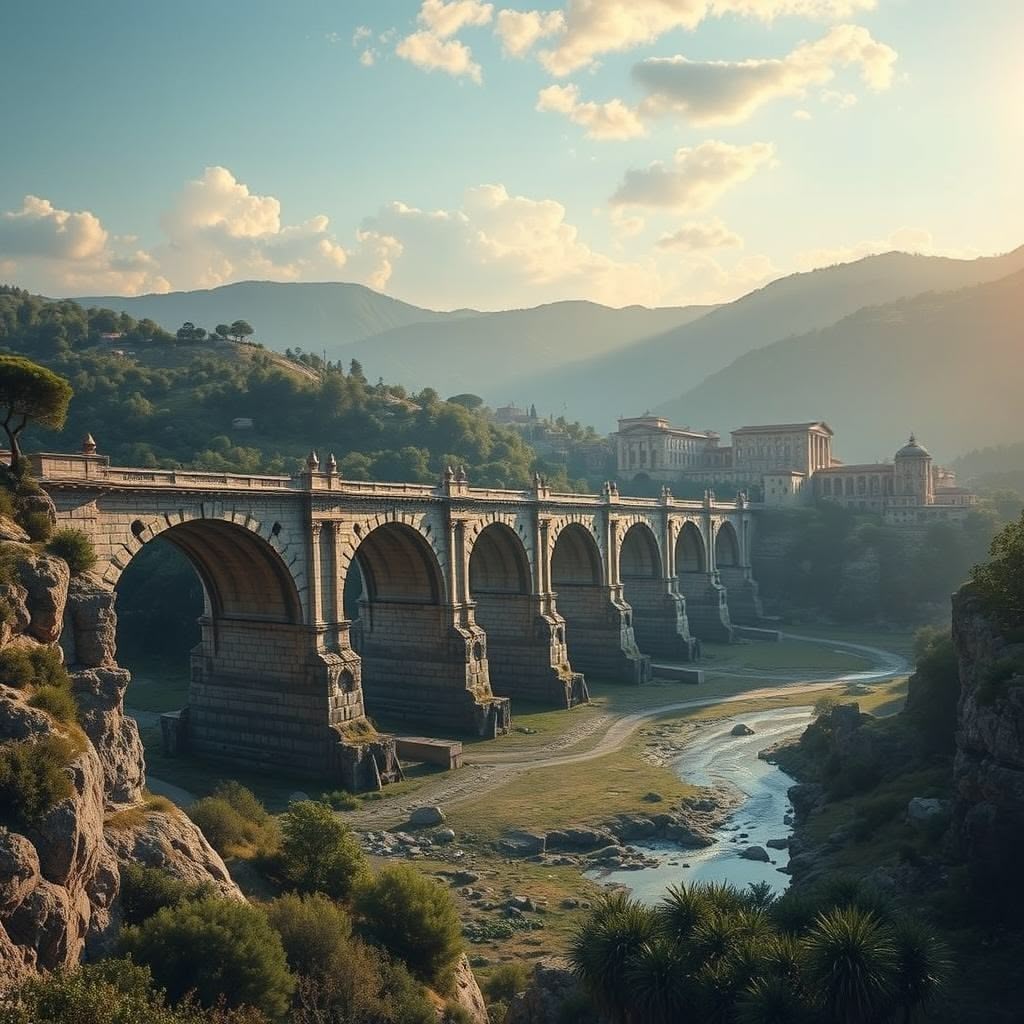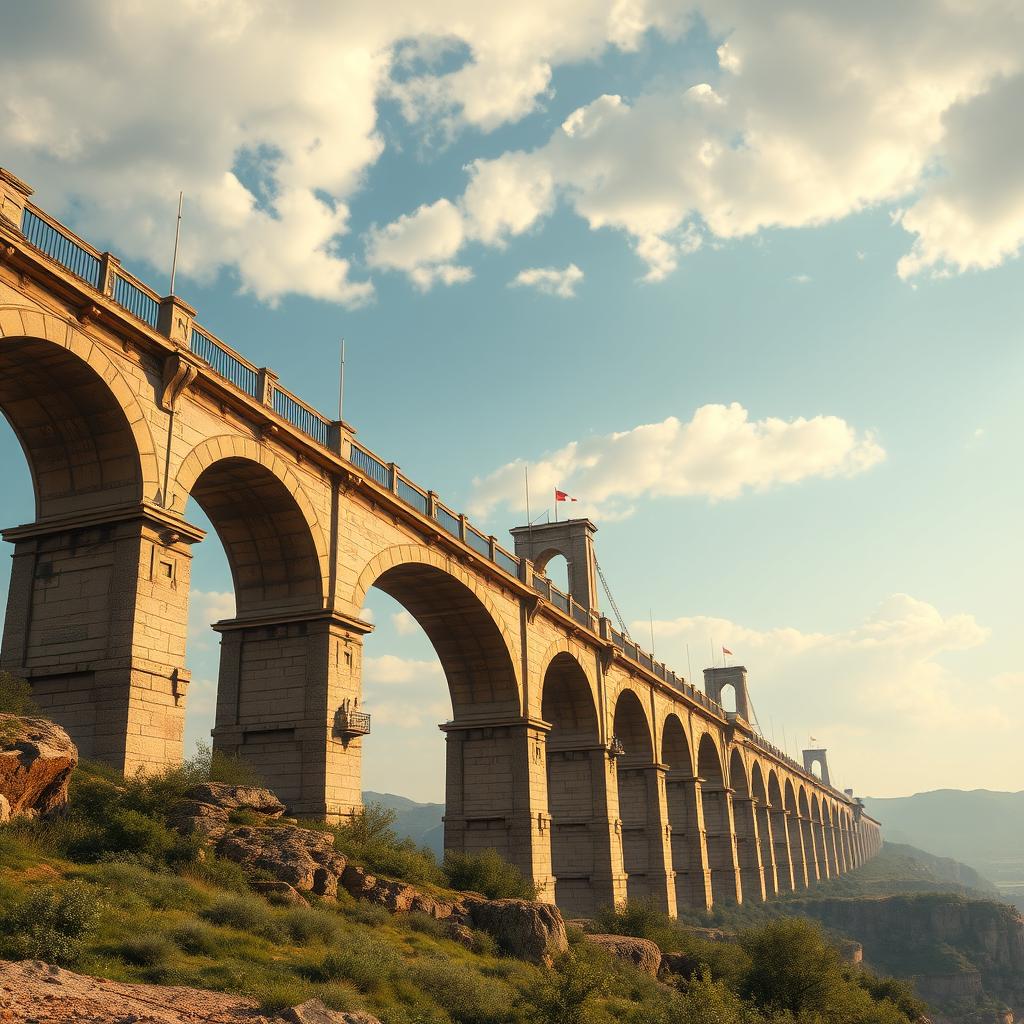The Roman Empire was known for its incredible engineering skills, especially when it came to building bridges. These structures were more than just ways to cross rivers; they were crucial for the empire’s military and administrative operations, allowing for quick movement of troops, trade, and communication over large areas.
Bridges played a key role in helping the Romans maintain control over different regions that were separated by natural obstacles like rivers and valleys. Their ability to construct stable and long-lasting bridges set new standards in engineering. The longest Roman bridges showcase innovative use of materials and design techniques that have influenced bridge construction throughout history.
In this article, we will explore some of the most impressive examples of Roman bridge engineering, focusing on the longest bridges built during the height of the empire. We will examine how these structures combined practical construction methods with groundbreaking innovations to achieve feats that remained unmatched for centuries.
Trajan’s Bridge over the Danube: The Pinnacle of Roman Bridge Engineering
Trajan’s Bridge is an extraordinary achievement in ancient engineering, built during Emperor Trajan’s military campaign against the Dacians around 105 AD. Designed by the famous architect Apollodorus of Damascus, this bridge allowed for quick movement of troops and support across the challenging Danube River, an important boundary for the Roman Empire.

Key features that make Trajan’s Bridge exceptional:
- Length: Approximately 1,135 meters (3,724 feet), making it the longest ancient bridge ever built.
- Width: Around 15 meters (49 feet), wide enough to accommodate two lanes of military traffic.
- Height: Reaching 19 meters (62 feet) above the water level, allowing river navigation beneath.
The bridge combined stone masonry with timber in an innovative way. It was supported by 20 massive masonry piers spaced evenly across the river. Each pier upheld wooden arches that spanned roughly 38 meters (125 feet). These arches formed the main load-bearing elements, distributing weight efficiently while allowing flexibility during river flow changes.
Advanced construction methods used by the Romans:
- Use of wooden caissons enabled workers to build solid foundations underwater by creating dry work chambers inside the riverbed.
- The Romans employed a system to divert parts of the Danube’s flow, minimizing water pressure on construction sites.
- Materials included durable bricks, mortar mixed with volcanic ash (pozzolana), and timber, chosen carefully for resilience against water damage.
Trajan’s Bridge held the record as the longest arch bridge in history for more than a thousand years, unmatched until modern engineering breakthroughs centuries later. Its combination of scale, materials, and construction technique exemplifies Roman mastery in bridging vast waterways under challenging conditions.
This engineering marvel not only served immediate military purposes but also showcased how Roman innovation pushed boundaries to connect and control their vast empire efficiently. The influence of such engineering feats extends beyond mere functionality; they serve as a testament to the broader impact of Roman engineering on contemporary infrastructure systems.

Other Notable Roman Bridges Demonstrating Engineering Excellence
Roman engineering prowess is further exemplified by several other remarkable bridges that showcase durability, architectural innovation, and historical significance:
1. Pons Fabricius
This ancient bridge, constructed in 62 BCE, still stands as a functional crossing over the Tiber River in Rome today. Also known as the “Fabricius Bridge,” it serves as a testament to Roman engineering longevity and practicality.
2. Pons Aemilius
Regarded as Rome’s first permanent stone bridge, the Pons Aemilius was built between 179 and 142 BCE. Its enduring presence underscores the Romans’ mastery of stone construction techniques for creating lasting infrastructure.
3. Ponte d’Augusto
Situated in Narni, Italy, Ponte d’Augusto boasts an impressive span of 159 meters (520 feet). Constructed around 27 BCE, this bridge showcases the Romans’ ability to engineer structures with substantial dimensions that could withstand the test of time.
4. Alcántara Bridge
Spanning the Tagus River in Spain, the Alcántara Bridge, commissioned under Emperor Trajan, stretches approximately 180 meters (590 feet). Its construction highlights the Roman Empire’s reach and influence in various regions, showcasing their expertise in building monumental bridges beyond Italy.
Each of these bridges symbolizes a blend of function and form—a hallmark of Roman engineering excellence. From practicality to grandeur, these structures have stood for centuries as a testament to the innovative spirit and technical ingenuity of ancient Roman engineers.
While exploring these architectural marvels, one cannot help but delve into the spectacle of ancient Rome which included gladiators and chariot races. Such events were not just entertainment; they played a significant role in shaping social relationships and political authority during that era.
Moreover, understanding how the Twelve Tables shaped Roman legal systems provides insight into the legal framework that governed these monumental constructions. These laws were instrumental in codifying complex legal practices of ancient Rome.
Additionally, daily life in ancient Rome varied significantly across social classes. This divide influenced everything from daily activities to traditions and ways of living.
Finally, exploring ancient Rome offers a journey through time, revealing how this small settlement along the Tiber River evolved into one of history’s most powerful empires. The story of Rome is not merely one of conquest and expansion; it is also a tale of innovation, culture, and governance that has left an indelible mark on the world.
The significance of Roman roads in maintaining and expanding this vast empire cannot be overstated. These roads were crucial in facilitating trade, military movements, and cultural exchange across different regions.

The Innovative Materials and Techniques Behind Roman Bridge Construction
Roman Engineering Marvels: How the Empire Built the World’s Longest Bridges relied heavily on a sophisticated blend of materials and construction methods that set them apart.
Key Construction Materials
- Travertine Limestone: A durable, easily quarried stone used extensively for facing and decorative elements. Its robustness helped bridges withstand centuries of wear.
- Volcanic Ash Cement (Pozzolana): This natural volcanic ash combined with lime created Roman concrete, a revolutionary material known for its exceptional strength and longevity. Pozzolana cement allowed underwater setting, crucial for building sturdy piers in rivers.
- Bricks and Wood: Bricks were often used in masonry piers and arches, providing a uniform size for faster construction. Wood served as temporary scaffolding, arch formwork, and in some cases, permanent structural elements like arches or decking.
Binding Agents: Lime Mortar and Gypsum
The Romans refined the use of lime mortar, a mixture of calcium oxide and sand, to bind stones tightly. Gypsum was sometimes added to improve setting times and durability in specific environments. These mortars contributed significantly to the integrity and resilience of bridge masonry.
Arch Design: Semicircular and Segmental Arches
Stone arches were fundamental to Roman bridge design due to their ability to distribute loads effectively:
- Semicircular Arches: The classic Roman arch shape, providing excellent compressive strength. Seen prominently in early bridges such as Pons Fabricius.
- Segmental Arches: Flatter than semicircular, these arches allowed longer spans with reduced height, enhancing clearance over rivers. Used in later constructions where wider navigable passages were required.
This mastery of arch geometry enabled spans previously unimaginable, combining structural soundness with elegant aesthetics.
Innovative Construction Techniques
- Wooden Caissons: Large watertight wooden boxes sunk into riverbeds formed secure foundations by allowing workers to excavate underwater safely. This technique was vital for erecting massive masonry piers, like those supporting Trajan’s Bridge.
- River Flow Diversion: Engineers temporarily diverted watercourses using cofferdams or channels to create dry working areas for pier construction. Managing river dynamics minimized delays caused by floods or strong currents.
These advanced methods showcase how Roman engineers overcame natural challenges to realize monumental projects. Mastery over materials like pozzolana cement combined with innovative foundation techniques made it possible to build some of the longest and most enduring bridges known from antiquity.
Interestingly, the influence of Roman engineering extends beyond architecture into other fields including law. Roman Law, which originated in ancient Rome around 753 BCE, has played a crucial role in shaping modern legal systems. Its principles are still relevant in various legal systems today, highlighting the enduring legacy of Roman innovations across multiple domains.
Types of Roman Bridges: From Stone Arches to Wooden Trestles
Roman bridges can be broadly categorized into stone arch bridges and wooden or pontoon bridges, each serving specific functional and environmental needs.
Stone Arch Bridges
Stone arch bridges, constructed primarily from masonry and concrete, employed semicircular or segmental arches that distributed loads efficiently and ensured longevity. These structures were built to span permanent waterways, providing durable crossings capable of supporting heavy military and civilian traffic. The design of these bridges often followed principles that can be observed in many historic structures, such as those detailed in the Historic Context Report on Highway Bridges in Maryland.
Wooden Trestle Bridges
Wooden trestle bridges contrasted with stone arches by using timber frameworks supported on piles driven into riverbeds. These were quicker to build and often temporary, ideal for military campaigns requiring rapid river crossings.
Pontoon Bridges
Pontoon bridges, made from boats linked side-by-side with planks laid across them, offered flexible solutions for crossing wide rivers during troop movements but lacked permanence.
Structural innovations such as flood openings—small arches or voids within piers—were integrated into many stone bridges. These openings lessened the water pressure against the piers during floods, reducing damage risk.
Military considerations influenced bridge design significantly. Fortifications including towers or gatehouses were sometimes incorporated at bridgeheads to control access and defend critical crossings. The Romans adapted their engineering methods to span vast rivers like the Danube and Rhine by combining strong foundations with multiple arches or extensive timber frameworks, balancing durability with strategic requirements.
The Lasting Impact of Roman Bridges on Modern Engineering
The durability of Roman bridges can be attributed to their robust materials and design principles. These bridges have withstood the test of time, surviving into modern times due to their strong construction. However, after the 2nd century CE, there was a noticeable decline in large-scale bridge building. This was largely due to political instability and economic challenges that plagued the Roman Empire during this period.
Despite these challenges, some Roman bridges were able to withstand the impact of barbarian invasions. Yet, their lasting influence can be seen in subsequent bridge engineering throughout history. The principles established during the Roman era continue to shape modern engineering practices.
This enduring legacy is not just limited to bridges but extends to various facets of Western civilization, thanks to the profound influence of Ancient Rome. From governance structures that laid the foundation for modern democracies, as seen in the structure of power during the Roman Republic, to advancements in various fields including architecture and engineering, Rome’s impact is both profound and enduring.
Conclusion
Roman engineering achievements showcase a perfect blend of practical construction methods and architectural innovation, resulting in some of the world’s longest and most enduring ancient bridges. These structures are not just functional; they are masterpieces of ancient engineering that reflect the Empire’s innovative spirit.
The legacy of Roman engineering is evident in these awe-inspiring infrastructure marvels. The Empire’s ingenuity, which seamlessly combined practicality with architectural splendor, stands as a monumental achievement in bridge construction. These bridges not only connected lands but also bridged the past with the present, leaving a lasting impact on the history of engineering.
The remarkable accomplishments of the Romans in creating enduring structures continue to inspire and fascinate us today. Their unmatched skill in building bridges that withstand the test of time and technology reflects their overall influence on various aspects of life, such as law seen in the lasting impact of the Corpus Juris Civilis on modern law, and the social dynamics represented by the lives of plebeians in ancient Rome.
Furthermore, the shift from monarchy to a republican system during the birth of the Roman Republic marked a significant change in governance that has had a lasting impact on modern political structures. Through all these aspects, the legacy of the Roman Empire continues to resonate, showcasing their unparalleled contributions to architecture, law, politics, and society.

